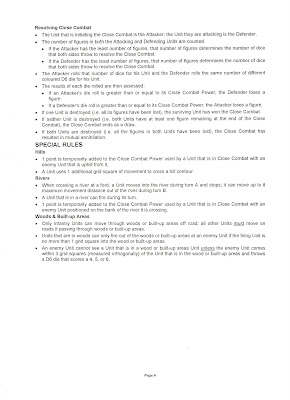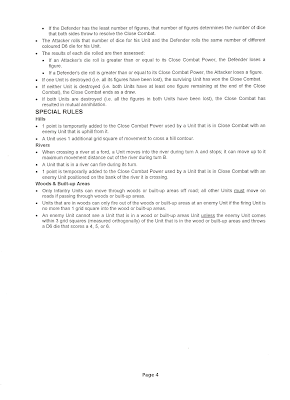Scenario
After they capture of Fort de Gre the commander of the Morschauserland Colonial Corps (MCC) mobilized as many troops as he could to assault and re-take the fort. He called this new military command the 'Fezian Frontier Field Force', and it comprised:

Because the main rule mechanisms are already well tested, this battle report will concentrate on the main events of the battle and will not report in detail on dice throw and its results.
Turn 1
The Morschauserlanders carefully advanced in an extended line towards the fort, making sure that their Infantry Units kept out of rifle range. The Artillery Units of both sides exchanged fire, and the Morschauserlanders inflicted two casualties on the Fezian Artillery Unit.

The artillery duel continued, but neither side was able to inflict any casualties on the other. In the meantime the 1st MCC Machine Gun Unit opened fire on the 1st Fezian Militia Infantry Unit, and despite the fact that the Fezians were behind earthworks, they managed to kill a Militiaman for the loss of one of the machine gun crew. The three Morschauserland Units on the left flank engaged the 1st Fezian Infantry Unit and cause two casualties for no loss whilst the two Infantry Units on the right (2nd MCC Native Infantry Unit and 1st New Morschauserland Native Police Infantry Unit) successfully engaged in a firefight with 1st Fezian Machine Gun Unit, killing two of the machine gun crew in the process.




The inexorable advance of the MCC continued, and despite valiant attempts by the defenders to deter them, they managed to reach the defences of Fort de Gre. The 1st Morschauserland Artillery Unit opened fire on the 1st Fezian Artillery Unit, thus making it possible for the Infantry Units on the left wing to close with the enemy.




This second play-test reinforced the fact that the rules work well as they currently stand. The next step will be to base some sword and spear-armed Native single figure bases so that I can test the minor changes to the rules that I have mentioned in recent blog entries.
After they capture of Fort de Gre the commander of the Morschauserland Colonial Corps (MCC) mobilized as many troops as he could to assault and re-take the fort. He called this new military command the 'Fezian Frontier Field Force', and it comprised:
- 1st MCC Infantry Unit
- 1st MCC Native Infantry Unit
- 2nd MCC Native Infantry Unit
- 1st New Morschauserland Police Infantry Unit
- 1st New Morschauserland Native Police Infantry Unit
- 1st MCC Artillery Unit
- 2nd MCC Artillery Unit
- 1st MCC Machine Gun Unit
- 1st Fezian Zouaves of the Guard Infantry Unit
- 1st Fezian Infantry Unit
- 1st Fezian Militia Infantry Unit
- 1st Fezian Artillery Unit
- 1st Fezian Machine Gun Unit
NoteThe defenders of Fort de Gre.
Because the main rule mechanisms are already well tested, this battle report will concentrate on the main events of the battle and will not report in detail on dice throw and its results.
Turn 1
The Morschauserlanders carefully advanced in an extended line towards the fort, making sure that their Infantry Units kept out of rifle range. The Artillery Units of both sides exchanged fire, and the Morschauserlanders inflicted two casualties on the Fezian Artillery Unit.
Turn 2The Fezian defences as seen from behind the initial Morschauserland Artillery positions.
The artillery duel continued, but neither side was able to inflict any casualties on the other. In the meantime the 1st MCC Machine Gun Unit opened fire on the 1st Fezian Militia Infantry Unit, and despite the fact that the Fezians were behind earthworks, they managed to kill a Militiaman for the loss of one of the machine gun crew. The three Morschauserland Units on the left flank engaged the 1st Fezian Infantry Unit and cause two casualties for no loss whilst the two Infantry Units on the right (2nd MCC Native Infantry Unit and 1st New Morschauserland Native Police Infantry Unit) successfully engaged in a firefight with 1st Fezian Machine Gun Unit, killing two of the machine gun crew in the process.
The Morschauserland 'Fezian Frontier Field Force' advanced towards Fort de Gre in an extended line, with the Artillery Units in the centre.
The left flank of the Morschauserland 'Fezian Frontier Field Force'.
The 1st and 2nd Morschauserland Artillery Units engaged the Fezian defenders with little effect.
Turn 3The 1st Fezian Zouaves of the Guard Infantry Unit occupied the centre of the Fort de Gre's defences. To their left was the 1st Fezian machine Gun Unit and to their right was the 1st Fezian Artillery Unit.
The inexorable advance of the MCC continued, and despite valiant attempts by the defenders to deter them, they managed to reach the defences of Fort de Gre. The 1st Morschauserland Artillery Unit opened fire on the 1st Fezian Artillery Unit, thus making it possible for the Infantry Units on the left wing to close with the enemy.
On the right flank the 1st New Morschauserland Native Police Infantry Unit had also assaulted the Fezian defences, but had not yet been able to drive off the 1st Fezian Militia Infantry Unit that they faced. The 1st MCC Machine Gun Unit engaged its opposite number, the 1st Fezian Machine Gun Unit, but was unable to inflict any casualties on that Unit. It was left to the 2nd MCC Native Infantry Unit to assault the section of defences occupied by the 1st Fezian Machine Gun Unit, and in the ensuing Close Combat they overcome the last remaining member of the Fezian Unit at no cost to themselves.The 1st New Morschauserland Police Infantry Unit fired at the Fezian defenders and charged home. In the ensuing Close Combat both sides lost two men, leaving the 1st New Morschauserland Police Infantry Unit as the victors. The 1st MCC Infantry Unit, who had already flanked the Fezian defences, but whose fire had been ineffective, can be seen tot he left of the picture.
The 1st MCC Machine Gun Unit fired at the 1st Fezian Machine Gun Unit, but caused no casualties. The 1st New Morschauserland Native Police Infantry Unit can be seen engaging the 1st Fezian Militia Infantry Unit in Close Combat.
At this point all was lost for the Fezians. They had fought well, but despite their extensive defences the luck had not been with them on the day. The commander of the 1st Fezian Zouaves of the Guard Infantry Unit offered to stop the bloodshed by giving up the fort, and his troops were allowed to withdraw unmolested. Fort de Gre was back in Morschauserland hands again ... but for how long?The 2nd MCC Native Infantry Unit assaulted the defences occupied by the 1st Fezian Machine Gun Unit. Sheer weight of numbers told, and they were able to kill the last remaining defender without loss.
ConclusionsThe battlefield just before the Fezian surrender. Had the battle continued there was little likelihood that the Fezians could have prevailed in the end, and so they withdrew to fight another day.
This second play-test reinforced the fact that the rules work well as they currently stand. The next step will be to base some sword and spear-armed Native single figure bases so that I can test the minor changes to the rules that I have mentioned in recent blog entries.
































.jpg)













